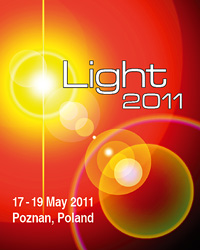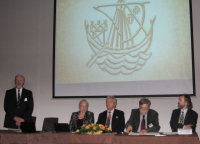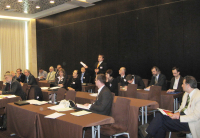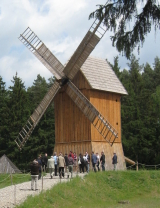Light 2011
1st International Conference on Light in Engineering, Architecture and the Environment
17 - 19 May 2011
Poznan, Poland
Overview
 The first International Conference on Light in Engineering, Architecture and the Environment (Light 2011) has taken place in Poznan, organised by Poznan Technical University (PUT) and the Wessex Institute of Technology (WIT), UK.
The first International Conference on Light in Engineering, Architecture and the Environment (Light 2011) has taken place in Poznan, organised by Poznan Technical University (PUT) and the Wessex Institute of Technology (WIT), UK.
The Conference Chairmen were Professor Konrad Domke from PUT and Professor Carlos A Brebbia of WIT. The meeting was opened by Professor Alexander Rakowska, Rector of PUT, who explained the importance of Poznan in Polish historic culture. The city used to be the capital of the country and the site of the first Christian Church in Poland. There are many sites to visit and the Old Market is particularly rich in heritage architecture, including a famous Renaissance Town Hall.
Poznan is also an important educational centre with a large number of students living in town. PUT alone has 20,000 of them and the Faculty of Electrical Engineering, to which Professor Domke belongs, is well known throughout the world.
PUT has built strong links with many other institutions around the world - including WIT - and fully participates in many EU initiatives. The campus continues to increase and improve its facilities. Professor Carlos Brebbia then introduced the work of WIT which sees itself as dedicated to knowledge transfer stressing interdisciplinary activities. This is carried out by a series of initiatives such as joint research programmes with other institutions, courses and conferences and a series of publications. Professor Brebbia stated the importance of the conference programme as a way of bringing together researchers and practitioners from different fields. The conferences give rise to a series of publications, the first of them the conference proceedings which are distributed in paper and digital format and permanently archived online at http://library.witpress.com. The conferences also give rise to some of the papers published in some of the interdisciplinary Journals published by WIT Press, the publishing arm of the Institute.
Professor Carlos Brebbia then introduced the work of WIT which sees itself as dedicated to knowledge transfer stressing interdisciplinary activities. This is carried out by a series of initiatives such as joint research programmes with other institutions, courses and conferences and a series of publications. Professor Brebbia stated the importance of the conference programme as a way of bringing together researchers and practitioners from different fields. The conferences give rise to a series of publications, the first of them the conference proceedings which are distributed in paper and digital format and permanently archived online at http://library.witpress.com. The conferences also give rise to some of the papers published in some of the interdisciplinary Journals published by WIT Press, the publishing arm of the Institute.
Professor Brebbia ended by mentioning that WIT is always keen to discuss joint initiatives and projects. WIT – Professor Brebbia said – welcomes visits by our colleagues and hopes that some of the participants will consider staying at its New Forest Campus when they are in the region.
Opening Address by Professor Konrad Domke
Professor Konrad Domke then introduced the topic of the conference. Light – he said – is a mysterious, weightless, almost non-material substance, that surrounds all of us, that brings the peace of the day at dawn, that extends the space around us, making it accessible to our senses and that impacts our life, activity, and aesthetic considerations. The symbol of divinity, life, truth and beauty. A force that guarantees life throughout the Earth’s entire biosphere. Human civilization is a history of man’s struggle to control and subdue light: the first camp fires, torches, cressets, candles, kerosene lamps and at the end all possible kinds of electric lamps each are more efficient than the previous one – such are the stages of the rise of our civilization. Our efforts yield increasingly spectacular results. Our current, very efficient light sources let us disengage the rule of day and night. Not only can we freely shape our light environment but also use the light to send information, cure ailments and enhance our aesthetic sensations.
Light is the key and unifying force to all the conference sessions. The light for architectural purposes, required by people indoors for work and leisure, the light that models architectural shapes from inside and outside to make them more attractive, the light of the road that makes it safe and accessible even at night, the light boosting our activity and bringing relief in sickness and suffering.
This conference – Professor Domke said – has attracted scientists dealing with lighting techniques and architecture as well as experts in other fields of science and art related to the use of light. The meeting was a chance for in-depth discussion of various aspects of the use of light for all types of technical purposes, art and the environment. New calculations methods and tools, computer aided visualisation of illuminated objects, improvements in design of architectural objects and construction of lighting equipment, issues related to improvements in their operating, measurement of quantity and quality of light and efficiency are the main topics of the meeting.
Keynote Address by Professor Paweł Baranowski
The Keynote Address at the conference was delivered by Professor Paweł Baranowski from PUT on the topic ‘Light Painted Impressions’. His talk concentrated on the way in which the eye processes different objects, and way in which this lighting can confuse our perceptions.
Professor Baranowski described the five basic stages of seeing; Sensation, Emotional Evaluation, Semantic Evaluation, Evaluation of Metaphysical Meaning and Persuasive Action. He explained how these classifications are exploited in marketing and influence us as consumers. Colours, for instance, are associated with different types of products, although their perception depends also on our particular cultural environment. In most cases, for instance, one concentrates on what ones mind thinks is important and omits the rest of the picture. During his lecture, Professor Baranowski presented a very interesting set of examples to describe how we create ways of seeing the world.
Invited Presentations
The conference programme included two other invited presentations;
‘Digital billboards and road safety’
by Konrad Domke, Poznan University of Technology, Poland
‘Assessment and measurement of energy demand and efficiency in public lighting networks’
by Dionys Gasparovsky, Slovakia University of Technology, Slovakia
Conference Sessions

The papers were divided into the following different sessions;
- Architectural lighting design and applications
- Illumination of architectural objects
- Light and human health
- Outdoor lighting
- Indoor lighting design and applications
Special Paper by Dr Pier Paolo Strona
A special paper was delivered by Dr Pier Paolo Strona, who in addition to his achievements as a research engineer at Fiat, has retained a continuous interest in photography. His paper, ‘Capturing the light’, aimed to show how beautiful artistic images can be created by capturing the light around us. Light allows us to see the reality of the world and can make even many ordinary things become objects of beauty or amazement. Pier Paolo explained some basic ideas about photography from the artistic point of view. He then considered daylight, moonlight and artificial light. The interaction of light with water and glass was examined focusing on its ability to generate surreal images. He concluded the presentation by giving several examples of ways of capturing light in photography.
Social Occassions
The delegates had plenty of occasions to meet in informal settings or at social events. They had lunch together and were offered a piano concert followed by a buffet dinner at the end of the first day.
The concert pianist was Dr Pier Paolo Strona who offered pieces from the following composers in his programme;
- F. Chopin (1810 – 1849) G. Notturno
- W. A. Mozart (1756 – 1791)
- L. Van Beethoven (1770 – 1827)
A dinner buffet was offered at the end of the concert to celebrate the occasion and allow the delegates, who were able to relax in a friendly atmosphere, to get know each other better.
Technical Excursion
 There was a technical excursion organised during the afternoon of the second day of the conference. The delegates visited the Phillips Plant in Piła, stopping first at the Museum of Rural Milling located in Jaracz on the Welna River on the fringes of the Notecka National Park. The main points of interest processing and milling exhibit, water mill industrial buildings and the windmill still in operation. There were, in addition, many other interesting displays.
There was a technical excursion organised during the afternoon of the second day of the conference. The delegates visited the Phillips Plant in Piła, stopping first at the Museum of Rural Milling located in Jaracz on the Welna River on the fringes of the Notecka National Park. The main points of interest processing and milling exhibit, water mill industrial buildings and the windmill still in operation. There were, in addition, many other interesting displays.
From Jaracz, the delegates proceeded to have a light lunch before arriving at the Philips Lighting Plant. They were shown around the House of Light, where there was a display of different light sources  followed by a factory visit. The activities of Philips Lighting focus on the manufacture of light sources, producing many types including those for energy efficiency and electronic lighting. The Philips Laboratory Lighting Applications Centre was created on the premises of Philips Poland to offer advice on energy efficient lighting solutions, and to improve visual comfort, the beauty of buildings facades and open spaces.
followed by a factory visit. The activities of Philips Lighting focus on the manufacture of light sources, producing many types including those for energy efficiency and electronic lighting. The Philips Laboratory Lighting Applications Centre was created on the premises of Philips Poland to offer advice on energy efficient lighting solutions, and to improve visual comfort, the beauty of buildings facades and open spaces.
The technical visit was a great success as evidenced by the number of questions and the level of interest shown by the delegates.
Conference Dinner

The conference banquet took place in a renowned restaurant located in the historic market place of Poznan. The menu consisted of a number of local specialities washed down with excellent Spanish wines. At the end of the dinner, Professor Carlos Brebbia thanked the Polish organisers for their hospitality and the efficiency of their organisation. He also gave the participants, as a souvenir, copies of some of the outstanding photographs shown during the presentation of Pier Paolo Strona.
Publication of Papers
The proceedings of Light in Engineering, Architecture and the Environment, 272pp (Print ISBN: 978-1-84564-550-2; Online ISSN: 1746-4498) are available from WIT Press priced at £117/US$234/€164. Orders can be placed on the WIT Press web site at www.witpress.com or by email:
Papers from the conference will also be hosted online at the WIT eLibrary as Volume 121 of WIT Transactions on the Built Environment (Online ISSN: 1746-4498). For more details visit the WIT eLibrary at http://library.witpress.com


 Wessex Institute
Wessex Institute